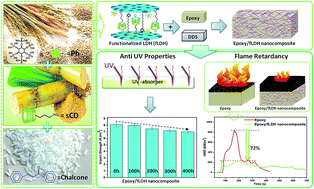Multifunctional intercalation in layered double hydroxide: toward multifunctional nanohybrids for epoxy resin†
Abstract
Multifunctional intercalation in layered double hydroxide (LDH) has been developed via designed multi-modifiers with varied functions in order to transfer these functions to epoxy materials by using nanocarriers. The functions of the multi-modifier system include: (i) functionalized hydroxypropyl-sulfobutyl-beta-cyclodextrin (sCD) and phytic acid (Ph) aiming at enhancing flame retardancy; (ii) sodium dodecylbenzenesulfonate (SDBS) enlarges the interlayer space of LDHs for facilitating LDH's dispersion in the epoxy matrix; (iii) chalcone imparts the anti-UV property to the epoxy matrix. In contrast to conventional LDH-based epoxy composites, the functionalized LDH-(fLDH) based epoxy nanocomposites show a significant improvement in both flame retardancy, such as passing the UL94 V0 rating and reduction of the peak heat release rate over 70%, and anti-UV properties in terms of well maintenance on the impact, flexural and micro-mechanical properties after 100, 200, 300, and 400 h of UV irradiation, respectively. Such multifunctional nanohybrids may be used to develop varied functional and sustainable epoxy-based materials for some advanced applications.


 Please wait while we load your content...
Please wait while we load your content...